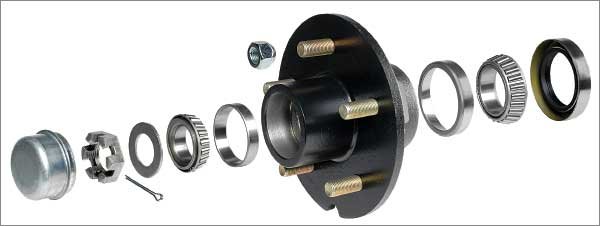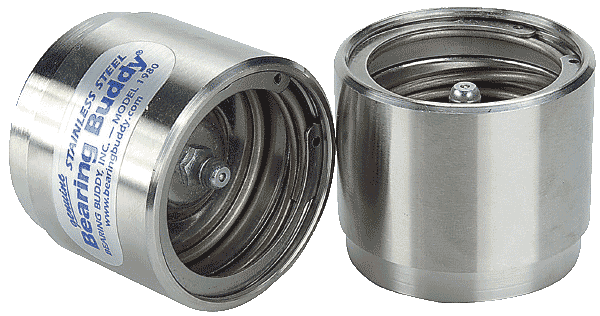Advertisement

Photo: Scott Sommerlatte
Anybody remember the butter-versus-margarine debates? The grease-versus-oil argument shares a lot of similarity with that healthy-heart question from the ‘80s, but in this case it's the health — and life span — of your trailer's wheel bearings that are in question. Until recently, you had two basic choices for keeping your wheel bearings running smoothly, and therefore your boat and trailer off the side of the highway: packing your bearings in grease and keeping that grease fresh by renewing it periodically, or using oil-filled hubs that bathe the bearings in oil as the tires rotate. Each has advantages and disadvantages. Now you've also got a third choice, a hybrid system that combines the best of both options and promises years of maintenance-free operation. But first, the basics.
Your trailer wheels have a hub in the center through which the spindle — the business end of the trailer axle — passes. The union between the hub and the spindle is made up of a pair of bearings — inner and outer — and their associated races, which are basically matching rings that the bearings ride inside. All of the weight carried by the axle rests (hopefully equally) on the bearings. So you can imagine how difficult it would be to spin the wheel if those bearings weren't smooth and slippery. Even so, when the wheel turns, friction creates heat, which is where the lubrication comes into play. Both grease and oil serve the same purpose inside the hub — they reduce friction and transfer heat away from the bearings and to the hub, where it can dissipate.
Tip
Carry a spare set of wheel bearings or hubs. If you don't know how or don't have the tools to replace them, the tow-truck operator will appreciate your having them ready to go.
The Old Standby

This exploded view shows, right to left, the inner seal, inner bearing and race, the hub, the outer race and bearing, washer and castle nut with a cotter pin, and cap.
Grease-filled hubs are the most common form on boat trailers. The chief advantage of grease is its viscosity — it stays where you put it. If the dust cap or bearing protector (more on those later) falls off when you're moving, the bearings will keep spinning for a good long while. A grease-filled hub also leaves little room for air inside the hub, which minimizes condensation.
The downside to grease is its longevity and the inability to visually examine your bearings without disassembly. For boat trailers, manufacturers recommend replacing the grease, which means removing, repacking, and reassembling each wheel on the trailer, every 3,000 to 4,000 miles, or annually even if you don't travel very far. While that may sound ridiculous if you only use your trailer a few times a season, it's because wear and tear won't wreck your bearings, but time will. And what matters to bearings is the amount of time in contact with moisture, which means every time you dunk your trailer, a clock starts ticking.
When your wheel hubs, heated by motion, hit the cool water at the boat ramp, everything inside contracts, creating a vacuum that can pull water into the hubs, contaminating the grease. This water will corrode your bearings over time, which increases friction, creating more heat and eventually leading to failure, and an unplanned stop at the side of the road. Bearing protectors, of which the Bearing Buddy brand is probably the most familiar, combat this by maintaining a small reserve of grease under pressure on the outer face of the hub. The idea is that the grease under pressure will push into the hub when it contracts, preventing water from ever intruding. If you keep the Bearing Buddy filled just enough to maintain pressure, the company claims you'll extend the service interval for your grease-filled hubs up to five years.

Some sealed grease hubs claim you don't need to reseal for six years.
There are also hubs designed to take the pain out of grease changes, such as the Vortex brand made by Tie Down Engineering, or E-Z Lube by Dexter. These have a zerk fitting for your grease gun on the front of the hub, but the grease travels down a channel inside the hub and appears at the rear, pushing new grease into and through the inner bearing, and eventually the outer bearing, displacing and replacing the old grease at the same time. Tie Down claims you shouldn't need to service a set of Vortex hubs for six years, thanks to its design and to a high-grade lithium grease from Lucas Oil with which the hubs are pre-filled at the factory.
Advertisement
Liquid Gold
Oil-filled hubs are more commonly found on the trailers under tournament fishing boats, and other brands whose owners typically tow long distances. Oil-filled hubs offer less resistance for slightly greater efficiency when towing, but their chief advantage is the service interval — as much as 40,000 miles between oil changes. You can also see at a glance whether your hubs are filled thanks to clear plastic caps on the ends of the hubs, visually inspect the condition of your outer bearings, and detect if your oil is deteriorating or contaminated. But those plastic caps are also a weak point. Crack one, by clipping another trailer in the boatyard or trailer parking lot, and your trip is over. Once the oil runs out of the hub, at highway speeds the bearings will stop turning in short order. Oil hubs are also more vulnerable to moisture born of condensation, as typically only half of the hub is filled. Without frequent rotation, the bearings above the oil line can be subject to corrosion. If you use your boat frequently, this isn't an issue. If not, you have to make a point of manually spinning your trailer tires every few weeks.
The Best of Both Worlds
It's not surprising then that an enterprising company would try to capture the advantages of grease under pressure and the longevity of oil-filled hubs in one neat package. The result is called The Vault — a pressurized, oil-filled hub that utilizes a "hybrid" oil with a viscosity approaching grease at normal temperatures but which thins out to the consistency of oil at operating temps. So you get the protection of a pressurized grease-filled hub, but the greater efficiencies of an oil-filled hub, and there's no recommended maintenance for five years. The Vault hubs come with a 10-year warranty.
Regardless of which hubs your trailer came with, keeping your bearings happy will keep you and your boat off the roadside. If you're unfamiliar with the repacking process, see the article "Know How: Bearing Straits" for a great video tutorial that shows you every step of the process.
Too Much of a Good Thing?

In our previous issue, contributor John Tiger claimed that bearing protectors "promote over-greasing," as "it's all too easy to add just one more pump of grease from the grease gun, when the hub and protector are already full." The consequence of this, he said, is grease pushing past the rear seals, ultimately shortening bearing life. After the issue was published, Bearing Buddy got in touch to give us more information: "The Bearing Buddy is designed to allow grease to seep out past the piston if the pressure inside the hub exceeds three psi," which is well within the design tolerances of most rear seals. "Excess grease comes out the front of the Bearing Buddy and not the seal area." We appreciate the clarification, and apologize for the confusion.
